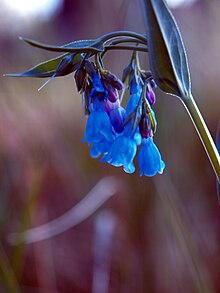| Mertensia lanceolata | |
|---|---|

| |
| Scientific classification | |
| Kingdom: | Plantae |
| Clade: | Tracheophytes |
| Clade: | Angiosperms |
| Clade: | Eudicots |
| Clade: | Asterids |
| Order: | Boraginales |
| Family: | Boraginaceae |
| Genus: | Mertensia |
| Species: | M. lanceolata
|
| Binomial name | |
| Mertensia lanceolata | |
Mertensia lanceolata, known as prairie bluebells, narrow-leaved languid lady, lance-leaved bluebells, and lance-leaved lungwort[3][4][1] is a species of flowering plant native to western North America.[1] A herbaceous perennial it has blue-green leaves alternately arranged on its smooth flowering stalk. Its flower buds are pink-purple and become more blue as they open. Accepted varieties include:[5]
Mertensia lanceolata is a variable species with flowering individuals typically growing 20–35 cm in height. The species is found in Rocky Mountain habitats from the plains to alpine habitats. The leaves are blue-green due to the waxy coating with a prominent center vein.[4] Immature plants will have a few distinctly lanceolate leaves arising from the ground on short stalks while plants mature enough to flower will typically have narrower leaves attached alternately attached to the flower stalk.
The leaves or flower stalks arise from the large taproot. Flowering stalks lean outwards at an angle with multiple flowers hanging downwards from the top of the stalk. The flowers are five fused petals forming a short trumpet.[6]
Flowering occurs in early May and continues through late June when conditions are favorable. Mertensia lanceolata becomes dormant by early summer, dying back to its substantial roots.[7]
Narrow-leaved languid lady is valued by wildflower gardeners for its dainty vibrant blue flower display and long season of blooming when moisture is good. They grow in either well draining or clay soils and is tolerant of limestone derived soils. Plants will live for many years when given space to grow its deep, branching taproot.[7]